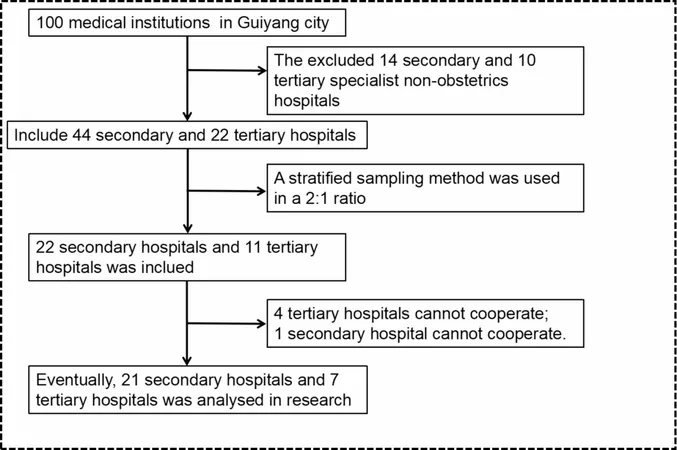
Unveiling the Cracks: The Dire State of Infection Control in Maternity Departments of China's Hospitals
2025-03-19
Author: Wei
Introduction
Pregnant women are particularly vulnerable to Healthcare-associated Infections (HAIs), which can lead to severe complications for both mothers and infants. This alarming reality highlights the urgent need for effective infection prevention measures in obstetrics departments. A recent study conducted in Guiyang City, Guizhou Province, aimed to assess the infection control management in the obstetrics departments of secondary and tertiary hospitals in the region. The results indicate a critical need for improvement in this area, which affects maternal and neonatal health significantly.
Study Overview
Carried out from July to December 2023, this cross-sectional study involved collaboration with 33 healthcare facilities in Guiyang City. Researchers used a thorough online survey, meticulously divided into five information-rich sections. These covered the hospitals' operational status, obstetric department basics, surveillance of HAIs, environmental and equipment assessments, and cleaning and disinfection practices.
Key Findings
Out of 33 invited institutions, 28 participated, marking a response rate of 85%. The results revealed significant disparities in the educational backgrounds of Infection Preventionists (IPs) in tertiary versus secondary hospitals. Most dramatically, secondary hospitals showcased an alarming lack of qualified IPs, relying predominantly on nursing professionals with fewer advanced degrees, while tertiary institutions benefitted from a more diversified and educated pool of infection control personnel.
Crucially, the data demonstrates that the barely sufficient presence of full-time IPs is particularly pronounced in secondary hospitals, prompting urgent recommendations. These institutions need to not only enhance staffing with well-qualified professionals but also establish robust monitoring systems for nosocomial infections.
Recommendations for Improvement
1. **Sufficient Staffing**: It is imperative that hospitals, particularly at the secondary level, increase the number of trained Infection Preventionists. The suggested ratio is ideally one IP for every 150-200 beds, but many institutions are falling short of this benchmark, indicating systemic neglect.
2. **Training Initiatives**: Regular training sessions for all healthcare staff must be prioritized, not just for medical personnel but also extending to patients and their families. Improved awareness and education about infection control can serve as a preventive measure against HAIs.
3. **Monitoring Systems**: Establishing an effective nosocomial infection monitoring system is essential for timely identification and management of HAIs. Advanced technological methods, such as real-time automatic monitoring systems, can significantly enhance detection and response capabilities.
4. **Environmental Enrichment**: Upgrading facilities to include amenities such as Labor, Delivery, and Recovery (LDR) rooms, which have shown promise in improving the childbirth experience, should be considered. However, their potential role in preventing infections warrants further exploration.
The Bigger Picture
As healthcare facilities strive to navigate the complexities of patient safety and infection control, this study shines a spotlight on the urgent need for systemic reform. The failure to adequately address these management and staffing issues not only threatens the health of mothers and babies but also presents a broader risk to public health. With nearly half of the surveyed hospitals failing to meet minimum staffing requirements, immediate and decisive action is necessary to improve maternal care and safeguard neonatal health.
Conclusion
In summary, this study offers a stark reminder of the vulnerabilities present in maternity care within China's healthcare system, emphasizing the need for enhanced infection control measures. The responsibility lies with hospital administrations to invest in training, staffing, and resources to ensure both maternal and infant safety. The outcome of such initiatives could redefine maternity care standards across the region, paving the way for healthier futures for mothers and their newborns.
In an era where patient safety can’t be compromised, it is imperative we take heed of these findings and act swiftly!



 Brasil (PT)
Brasil (PT)
 Canada (EN)
Canada (EN)
 Chile (ES)
Chile (ES)
 Česko (CS)
Česko (CS)
 대한민국 (KO)
대한민국 (KO)
 España (ES)
España (ES)
 France (FR)
France (FR)
 Hong Kong (EN)
Hong Kong (EN)
 Italia (IT)
Italia (IT)
 日本 (JA)
日本 (JA)
 Magyarország (HU)
Magyarország (HU)
 Norge (NO)
Norge (NO)
 Polska (PL)
Polska (PL)
 Schweiz (DE)
Schweiz (DE)
 Singapore (EN)
Singapore (EN)
 Sverige (SV)
Sverige (SV)
 Suomi (FI)
Suomi (FI)
 Türkiye (TR)
Türkiye (TR)
 الإمارات العربية المتحدة (AR)
الإمارات العربية المتحدة (AR)